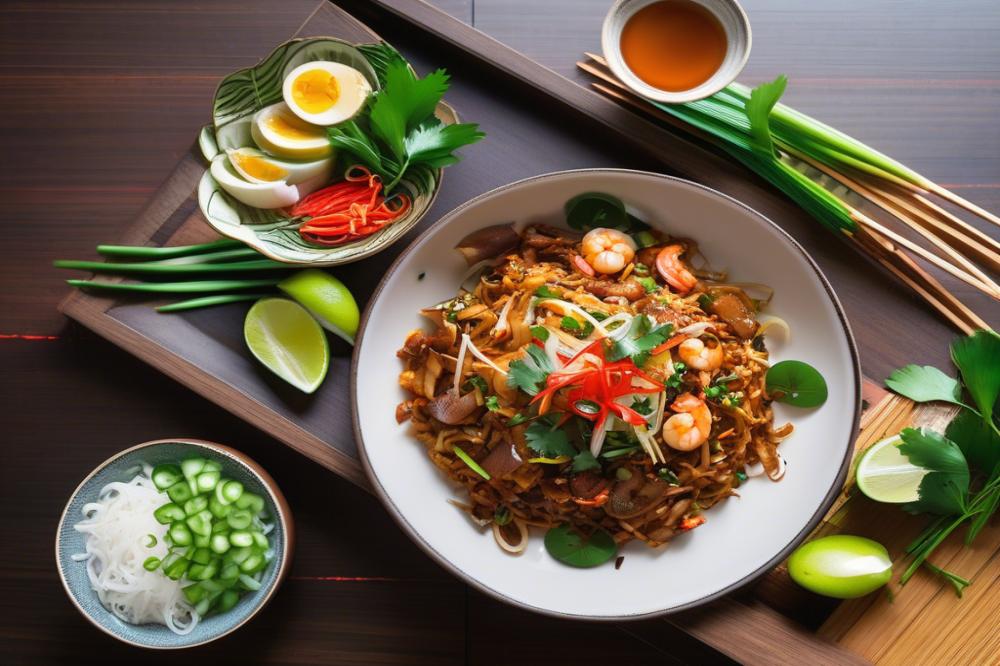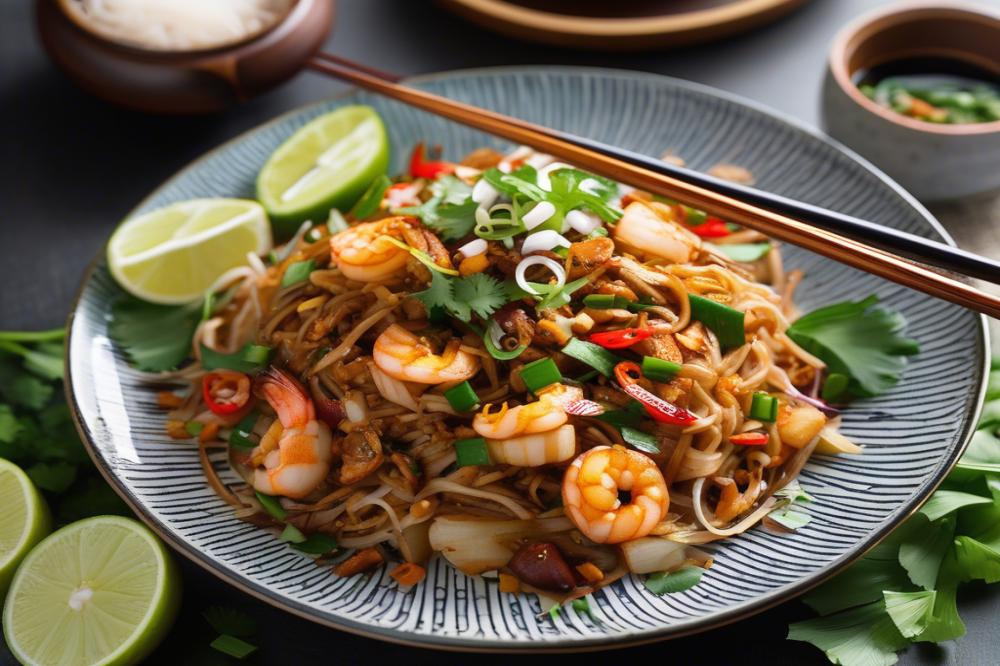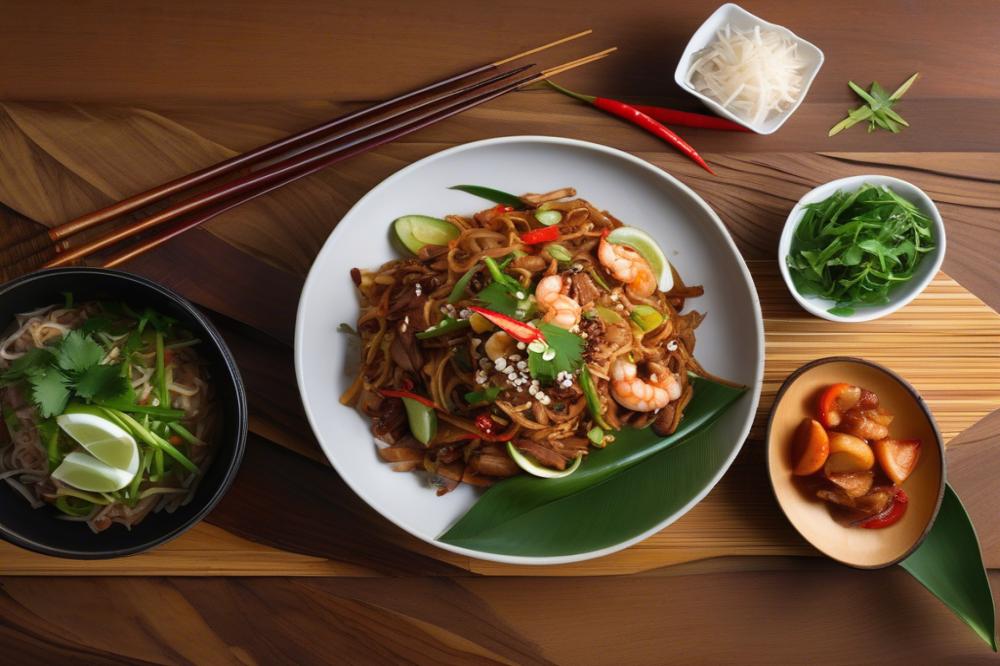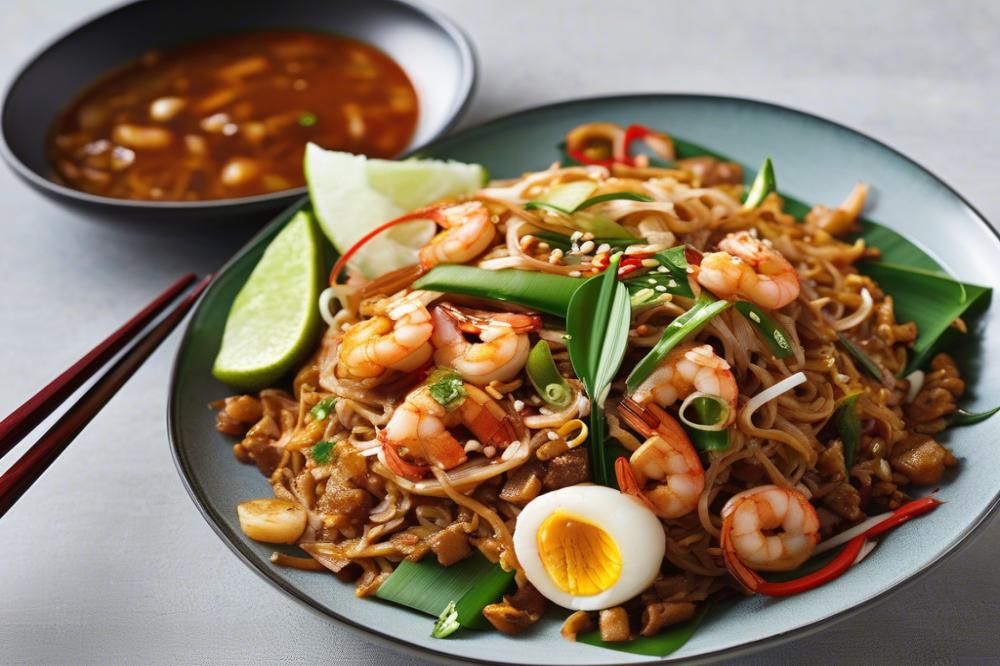Overview of Char Kway Teow as a Beloved Dish in Malaysian cuisine
Char Kway Teow is a beloved dish in Malaysian cuisine. This dish features Stir-Fried Flat Rice Noodles that are rich in flavor and texture. Many people enjoy its combination of ingredients, which include shrimp, bean sprouts, and Chinese sausage. Each bite offers a delightful experience with a smoky taste from the high heat of the wok.
Brief History and Cultural Significance of the Dish
The origins of Char Kway Teow trace back to Chinese immigrants who settled in Malaysia. They brought with them cooking techniques and flavors that evolved over time. This dish reflects a blend of Chinese and Malay culinary traditions. Its preparation is an art form, showcasing the skills of street vendors. For many, it represents comfort food that is both satisfying and delicious.
Importance of street food in Malaysia
Street food plays a vital role in Malaysia’s food culture. It serves as a gateway for locals and tourists to enjoy authentic flavors. The bustling night markets and food stalls offer a vibrant atmosphere. In these spaces, dishes like Char Kway Teow come to life, cooked fresh in front of eager diners. The experience is as much about the food as it is about the community and connection. Delicious meals are readily available, allowing everyone to savor the rich culinary heritage of Malaysia.
Understanding Char Kway Teow

Char Kway Teow is a popular dish in Malaysian cuisine, celebrated for its rich flavors and diverse ingredients. This delicacy consists primarily of thick flat rice noodles stir-fried in a hot wok. Key components include shrimp, bean sprouts, and Chinese sausage, which all contribute to its robust taste. Stir-frying in high heat helps achieve that smoky aroma, known as “wok hei.”
Street food markets showcase this dish prominently. Night markets and food stalls serve it quickly to hungry customers. The sizzling sound of the noodles hitting the hot metal pan attracts many. People often gather around vendors, drawn in by the enticing smell. It’s a lively and communal experience. Many locals and tourists enjoy indulging in this savory meal, making it a staple for anyone exploring the food scene.
Char Kway Teow stands apart from other rice noodle dishes. For instance, some noodles are served in soups or with a sauce. In contrast, this dish is dry and full of texture. Its unique blend of soy sauce and chili paste adds a kick of flavor that others may lack. While similar dishes can be found in various cuisines, none quite match the vibrancy and boldness of this Malaysian favorite.
Ingredients and Cooking Instructions

To create this delicious dish, you will need the following ingredients:
- 200g flat rice noodles
- 100g shrimp, peeled and deveined
- 50g Chinese sausage, sliced
- 100g bean sprouts
- 2 cloves garlic, minced
- 1 tablespoon chili paste
- 2 tablespoons soy sauce
- 1 tablespoon vegetable oil
Cooking Instructions
Begin by soaking the flat rice noodles in warm water for about 30 minutes. Softened noodles will cook evenly and absorb flavors well. Drain them thoroughly once they are pliable.
Heat the vegetable oil in a hot wok over medium-high heat. A hot wok is crucial for achieving that signature stir-fry texture. Once the oil shimmers, add the minced garlic. Stir-fry for about a minute until the aroma is released, but be careful not to burn it.
Add the sliced Chinese sausage. Stir-fry it until it turns a light brown color, releasing its oils. It’s time to toss in the shrimp after the sausage has cooked slightly. Cook the shrimp for about 2-3 minutes. They should turn pink and be fully cooked through.
Next, introduce the soaked flat rice noodles to the wok. Use your spatula to break up any clumps. Stir in the chili paste and soy sauce, mixing everything well to ensure the noodles are coated. This will bring rich flavors to your dish.
After a few minutes, throw in the bean sprouts. They add a delightful crunch and freshness. Stir-fry for another 1-2 minutes until they are tender but still crisp.
Once everything is well combined and heated through, your dish is ready to serve. Remember, the key to a great stir-fry is to continuously move the ingredients around. This allows for even cooking and prevents burning.
Tips for Achieving the Perfect Stir Fry in a Wok
Always use high heat when cooking. This is important for making sure everything cooks quickly and retains texture. Have all your ingredients prepped before you start cooking, as this will help the cooking process flow smoothly.
Instead of overcrowding the wok, consider frying in batches. This technique allows for better heat distribution and prevents steaming. Don’t be afraid to experiment with additional toppings, like green onions or a squeeze of lime. They can enhance the meal beautifully. Enjoy the process of making this unique dish!
Nutritional Information

When preparing Char Kway Teow, various ingredients come into play, each contributing to the dish’s overall nutritional profile. Understanding these components is essential for anyone interested in Malaysian cuisine and street food. Here’s a breakdown of the nutritional value of key ingredients.
Nutritional Breakdown of Each Ingredient
Flat rice noodles form the base of this dish. A typical serving of rice noodles contains about 200 calories. They are primarily made up of carbohydrates, which provide energy. Shrimp, often used in the recipe, adds around 85 calories per 100 grams. This seafood is a great source of protein and is low in fat, making it a healthy choice.
Bean sprouts, another common ingredient, are low in calories. About 100 grams of bean sprouts have only 30 calories. They also offer fiber, which aids in digestion. Garlic is another key player. One clove has roughly 4 calories but is rich in antioxidants and has various health benefits.
Chinese sausage, while delicious, is higher in calories. A 100-gram serving can contain about 300 calories due to its fat content. Adding just a small amount boosts flavor but should be consumed in moderation.
Caloric Values and Macronutrient Content
The caloric values of the ingredients combine to give you a full picture of what a serving of Char Kway Teow contains. Total calories may vary, but a standard plate could range from 400 to 600 calories, depending on the portion size and ingredients used.
Macronutrient breakdown reveals the protein, fat, and carbohydrates. Most of the energy comes from carbohydrates due to the rice noodles. Protein is primarily sourced from shrimp and sometimes additional meat. Fat content largely depends on the use of Chinese sausage and the type of oil used for cooking in the wok.
Health Benefits of Ingredients Used
Each ingredient not only contributes to the flavor but also offers health benefits. Shrimp is known for its high protein content, which can help build muscle. The antioxidants present in garlic may boost the immune system, adding another layer of health benefits.
Bean sprouts are packed with vitamins and minerals. They can enhance bone health and contain vitamin C, which is vital for skin health. Soy sauce, while flavorful, should be used sparingly due to sodium content. It does, however, provide a rich source of umami, enhancing the overall taste.
Chili paste introduces both heat and health benefits. Capsaicin, found in chili peppers, may aid in metabolism and pain relief. This unique combination of ingredients makes Char Kway Teow not just a meal but a delightful mix of nutrition and flavor.
Variations and Customizations
Common Variations of Char Kway Teow
Variations of this popular dish abound. In some places, you’ll find a seafood version packed with shrimp and squid. Others might use beef or chicken as the main protein. Tofu is a good option for vegetarians. Those who seek spice will often add more chili paste for an intense kick. You can also spot different types of sausages, like Chinese sausage, adding richness to the dish. Presenting choices like this showcases the diversity found in Malaysian cuisine.
Ingredient Substitutions for Dietary Preferences
Not everyone can enjoy the traditional ingredients. People with shellfish allergies can skip the shrimp and instead use mushrooms for texture. A gluten-free version is possible by swapping out regular soy sauce with a gluten-free alternative. For those avoiding meat, plant-based proteins can provide satisfactory substitutes. Using less oil can make the dish lighter as well. Each of these choices allows individuals to tailor their meal according to their specific needs.
Regional Differences in Preparation and Ingredients
In Malaysia, you’ll find street food vendors preparing this dish in unique ways. In Penang, char kway teow often features a smoky flavor due to high-heat cooking in a well-seasoned wok. The addition of fresh cockles is popular in this region. Conversely, around Kuala Lumpur, the dish can be more saucy with a heavier hand on soy sauce. Different areas emphasize distinct ingredients, such as the use of fresh vegetables or an array of spices. Each region brings its own flair, enriching the overall experience of this beloved street food.
Cultural Context and Serving Suggestions
Char Kway Teow holds a significant place in Malaysian street food culture. Vendors often prepare it in bustling night markets, where the sound of sizzling woks fills the air. The dish is renowned for its smoky flavor, achieved by cooking in a well-seasoned wok over high heat. Diners can spot it being cooked with shrimp, Chinese sausage, and vibrant bean sprouts, creating a colorful medley. Vendors serve it hot and fresh, garnished with a sprinkle of green onions and a drizzle of extra soy sauce for flavor.
Pairing this delectable dish with the right beverages enhances the tasting experience. A cold glass of iced tea balances out the dish’s richness, while a soft drink can add a refreshing contrast. For those craving a more traditional option, a local Malaysian coffee, known as “kopi,” can also complement the flavors beautifully. As for side dishes, fried spring rolls or roti canai are popular choices. They add texture and taste, making for a well-rounded meal.
Many cherish personal stories related to the first bite of Char Kway Teow. One might remember enjoying the dish at a bustling food stall, surrounded by laughter and chatter. The heat from the wok and the aromas wafting through the air create an unforgettable memory. Eating with friends and sharing bowls of this favorite can spark conversations. Each flavorful spoonful of rice noodles, pulled together by garlic and chili paste, seems to recall tales of family gatherings and joyous celebrations over savory meals.
Final Thoughts on Char Kway Teow
Char Kway Teow holds a cherished place in Malaysian cuisine. This dish not only showcases the region’s culinary diversity but also reflects the rich history and culture of local street food. Flavorful and satisfying, each bite provides a glimpse into the heart of Malaysia’s vibrant food scene.
Cooking this beloved dish at home can be a rewarding experience. With the right ingredients and a little practice, anyone can recreate the magic. The sizzling sounds and aromatic smells that fill the kitchen will transport you to the bustling streets where these noodles are traditionally enjoyed.
Sharing a meal like this brings people together. It sparks conversations about flavors, memories, and experiences. Street food is more than just food; it’s a celebration of community and culture. Trying to make Char Kway Teow can be a delightful adventure for food lovers. So gather your ingredients, roll up your sleeves, and dive into this iconic recipe. The joy of serving and sharing your creation may very well be as fulfilling as the dish itself.



